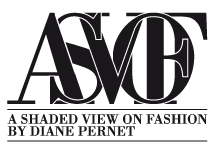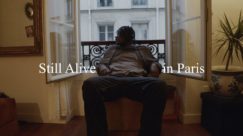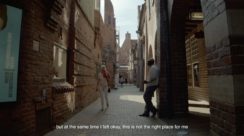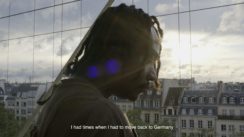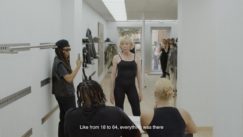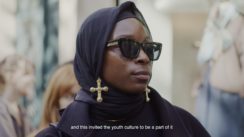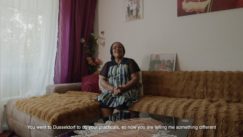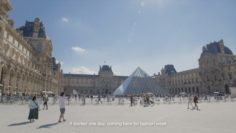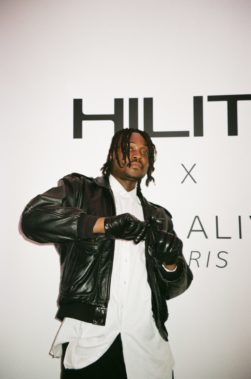Dear Shaded Viewers,
Paris, often hailed as the epicenter of global fashion, serves as the backdrop for Still Alive in Paris, a short documentary that delves into the life and work of Elliot De-Graft. Directed by Andrea Nazarian and produced by HILITE, the 7-minute film offers a thoughtful exploration of De-Graft’s journey as the Ghanaian-German designer behind the emerging brand Still Alive. The documentary provides an intimate look at his creative process, his inspirations, and his efforts to establish an independent label in one of the most competitive fashion landscapes.
The film begins in Bremen, Germany, De-Graft’s hometown, where his early experiences and influences are brought to life. These formative moments laid the foundation for Still Alive, a brand launched in 2021 that embodies resilience and timeless design. As De-Graft explains, Still Alive is more than a label—it’s a philosophy that reflects his personal journey and commitment to creating meaningful pieces.
The second half of the documentary shifts to Paris, where De-Graft is immersed in the day-to-day challenges of building his brand while preparing for his Spring/Summer 2025 collection. From sourcing fabrics to collaborating with his team, viewers witness the meticulous effort behind signature designs like Italian leather handbags and roll-neck jackets crafted with sustainable materials. Nazarian’s observational approach captures both the creative highs and moments of uncertainty, offering an honest portrayal of what it takes to succeed in fashion today.
For Nazarian, whose own background resonates with De-Graft’s experience as a child of immigrants, this project was about more than fashion—it was about telling a story of perseverance and self-expression. Through its understated lens, Still Alive in Paris invites viewers to reflect on the intersection of identity, creativity, and ambition.
Interview with film director Andrea Nazarian and Still Alive designer Elliot Degraft
Still Alive in Paris offers a deeply personal window into the identity behind a rising fashion label. How did the two of you collaborate to visually translate the philosophy of Still Alive into cinematic form?
Andrea: It really came down to open conversation and a shared understanding of what Still Alive stands for. Elliot was clear that the brand isn’t just about clothes. It’s about claiming space and overcoming adversity. So we kept coming back to that idea: how do we make the film feel like an extension of him?
We focused on contrast. Quiet moments and bold choices, softness and strength, because that’s where the brand lives. It was less about trying to define Still Alive in a literal way and more about creating a visual world that felt true to Elliot’s rhythm and perspective.
Elliot: From the beginning, Still Alive was rooted in something deeper: the simple but powerful fact of being alive – which includes pain, perseverance, and resilience. It was important to me that this wasn’t just a clothing line, but a reflection of my personal story – one that began in Germany and unfolded in Paris.
At the same time, I consciously created a brand that isn’t tied to me as a person – but one that anyone can relate to in their own way. Everyone has their own journey, their own reason to say: I’m still alive – and this message can be carried and expressed through clothing.
Andrea and I shared the same belief in storytelling that touches people on an emotional level. We chose a visual language that’s raw and unfiltered – to create something more intimate than a fashion film, something that feels real.
Andrea, with a background in dance and visual storytelling, and Elliot, your roots in both Ghanaian culture and the German fashion scene – how did both your experiences of movement, migration, and reinvention shape this project?
A: There’s definitely a shared understanding between us of what it means to move, whether it’s through places, cultures, and phases of life. Even though our paths are different, that feeling of constantly shifting and redefining yourself gave us quite a bit of common ground.
E: Identity has always been a central theme for me — not tied to a specific place, but something I’ve had to explore, discover, and ultimately define for myself.
With Ghanaian roots, raised in Germany, and now based in Paris, I often found myself in the in-between spaces — culturally, emotionally, and creatively. But it’s exactly within that in-between that I’ve built a sense of self. That’s where my work begins: from a place of fluid identity, rooted in creativity and shaped by the diverse community I come from and continue to build.
The documentary is crafted in two distinct chapters: Bremen and Paris. For both of you, how did location act not just as backdrop but as character – especially within the visual language of fashion?
A: The two cities felt like different emotional rhythms—Bremen was introspective, Paris was electric. That contrast gave us a strong visual foundation. We leaned into it with the pacing, the way the clothes moved, even the way we used light. It was about showing how fashion is shaped by where you are and where you’ve been.
E: To be honest, it was my idea to include Bremen – my hometown. When I told Andrea about it, she immediately understood the vision and said she would book the flights from Canada right away.
For me, it was deeply important to involve my mother in the process. For a long time, she didn’t really understand what I do, or what my work means – so bringing the documentary into my hometown was also a bridge between my personal and professional worlds.
Visually and emotionally, Bremen and Paris couldn’t be more different – and that contrast became a central part of the story. Bremen represents where I grew up, the silence before the noise – while Paris represents the energy of the fashion industry.
In the film, these places aren’t just backgrounds; they reflect identity, tension, growth.
Still Alive’s SS25 collection marks a bold step into both the luxury and sustainable fashion markets. How did you approach capturing the craftsmanship alongside the relentlessness of building a fashion label? Were there any moments during the filming process where something unexpected was revealed?
A: Capturing the interplay between craftsmanship and the relentless drive to build a fashion label is a delicate dance. How does one maintain poise while pushing to evolve and overcome challenges that at times feel devastating, all while ensuring that what you create truly reflects your identity and values?
One of the most unexpected moments came as we captured the Still Alive runway show shoot at Pont des Arts. The outdoor location and stormy weather came together and infused the scene with a raw quality that mirrored the spirit of the brand.
E: In 2022, I entered the Paris fashion scene, and that environment challenged me to evolve. I never want to stay in one lane. Every year, I want to look back and see progress — creatively, technically, and conceptually. With the SS25 collection, stepping into the luxury and sustainable fashion market was a conscious decision.
I wanted to show that Still Alive is not just another streetwear brand. The market is flooded, and I knew we had to make a statement: that we can play on the same field as high-end labels, with our own perspective. That meant working with materials like leather and less graphics or prints— from our signature shoulder bags to handcrafted jackets — while also being mindful of sustainability and craftsmanship.
It’s about pushing forward, without losing the cultural foundation that started it all. Streetwear will always be part of the DNA. But SS25 is a message: we’ve arrived in a new space, and we belong here. To reflect that evolution, we also shifted how we communicate visually — our main Instagram page now focuses on current product and storytelling, while our second Instagram page Still Alive Archives acts as a curated memory of past collections and creative milestones. It’s all part of the same identity — just viewed through different lenses. A special thanks to “Bastien Maea”, our Head Visual Designer, for his essential contribution to our visual and digital communication. His expertise in editing and 3D visual work has been a key element in elevating the creative direction of Still Alive Paris. We are proud to have him as part of our journey.
And yes — there was one moment during the process that revealed a lot about the spirit of Still Alive. We had originally planned a more traditional SS25 show in a private venue in Paris. The vision was to keep it exclusive, yet accessible to the community — with affordable tickets and a secret location.
However, due to unexpected last-minute complications with the venue arrangements and shifting conditions, we weren’t able to move forward with that plan. But instead of compromising the essence of the project, we adapted — and created something even more meaningful. We relocated the show to Pont des Arts, a bridge rich in culture and symbolism. It became an open-air runway above the water, blending public space with intimate experience. The location itself was still kept private — only ticket holders received access to the details. So while it was outside, it remained curated and exclusive.
We covered production costs as planned and maintained a high-quality setup — proving that creativity and constraint can coexist. In the end, it reflected exactly what Still Alive stands for: turning pressure into presence, and keeping fashion human, intentional, and connected to real life.
Sam Acton King’s cinematography leans more toward still composition than typical handheld documentary filming styles. How did that visual choice allow themes of creative pressure, self-expression, and belonging emerge more powerfully in a film about fashion?
A: Sam and I discussed this approach early on, and it felt like a natural fit for both his strengths and the subject matter. While it might have been easier to run around trying to capture the chaos of Paris, Sam encouraged us to slow down and really be present. There’s a lot of tension beneath the surface of Elliot’s journey, like water that’s still on the surface but turbulent underneath.The fashion industry itself is similar. Always presenting as beautiful and composed, yet in reality, full of chaos for the people involved.
Fashion films often transcend commercial roots, becoming cultural artifacts that capture the real spirit behind something. What did you set out to portray with Still Alive in Paris, and where do you see it sitting within this shifting space between fashion, storytelling, and documentary?
A: With Still Alive in Paris, our goal was to capture the essence of the brand beyond just the clothes. We wanted the film to feel real and intimate, showing both the highs and the tensions that come with building something from zero. We wanted the project to show the human experience behind the creation, the emotional push to evolve, the search for belonging, and the pressure of trying to make it all work.
E: In that sense, I see Still Alive in Paris as part of a growing shift, where fashion becomes storytelling, and storytelling becomes a form of cultural memory. The film captures a moment in time where identity, art, and resilience come together. And that’s what I wanted it to leave behind.
Later,
Diane
